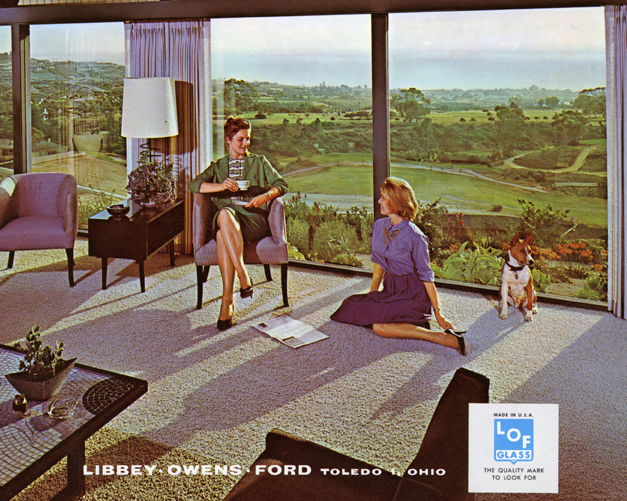
Image Credit: Images #1 and #2: Libbey-Owens-Ford
What’s a “solar house”? The phrase has been used since the 1940s to refer to a house with lots of south-facing glazing — a type of house later called a “passive solar house.” The phrase is also used to refer to homes that include an active solar thermal system (one with collectors on the roof, along with pumps or fans). Finally, the phrase has recently been applied to homes with a photovoltaic (PV) array on the roof.
Anyone interested in a thorough history of this subject should buy The Solar House by Anthony Denzer. (Denzer is also the author of a guest blog on GBA, “Historic Solar House Has Been Bulldozed.” Denzer’s blog recounts the sad fate of a solar house designed by George Löf, a researcher whose work is an essential part of the history of solar homes.)
Denzer’s history is academic and thorough. I thought it would be fun to take a different retrospective approach to this slice of architectural history: I decided to look back at how a leading newspaper, the New York Times, has used the term “solar house” over the last 60 years.
1945: “Houses Warmed by the Sun”
One of the first articles I found was published on April 15, 1945. The article, “Houses Warmed by the Sun,” was written by Mary Roche, who apparently depended heavily on press releases and promotional information issued by Libbey-Owens-Ford, an Ohio glass manufacturer. Libbey-Owens-Ford developed the insulated glazing unit (IGU), which it sold under the Thermopane brand name, and funded a significant advertising campaign promoting the so-called solar house. (In April 1986, Libbey-Owens-Ford sold its glass business to the Pilkington Group.)
Roche’s article refers to several Glenview, Illinois, homes designed by architect George…
Weekly Newsletter
Get building science and energy efficiency advice, plus special offers, in your inbox.

This article is only available to GBA Prime Members
Sign up for a free trial and get instant access to this article as well as GBA’s complete library of premium articles and construction details.
Start Free TrialAlready a member? Log in















7 Comments
Nice
I suspect the 'solar house' theory justifying large expanses of glass might not be entirely unconnected with the post WW2 modernist movement in the USA, trying to justify their use of large expanses of glass with a technical rationalization. But it is just a half baked theory... needs some scholarly research. :)
Half-baked theory?
More likely fully-baked with that amount of glazing!
Machine age
Just a footnote on the machine age: The term was used mostly from 1925 to 1950, according to a Google ngram search. From our perspective now, it might seem that by 1940, machines were no longer exciting and new, but machine technology was still advancing fast. The next major age was the atomic age, which became notorious a few months after the April 1945 article. Arguably electronics was also an important and rapidly advancing technology during this period, but "electronic age" wasn't mentioned much until after about 1950. As of April 1945, equating miraculous high technology with machines may have sounded right.
Is it just me, or does it
Is it just me, or does it look like the dog in that picture is thinking, "Wtf is all this bs?"
History
Thanks for the article on the history of passive solar. There have been growing pains over the years for sure. However, we've learned some lessons and passive solar is very under utilized, in my opinion. My own passive solar home in Vermont hasn't needed any additional heat for well over two weeks during a time when the outside temp has been below 50F roughly 95% of the time and under 40F the majority of the time. In a typical year, my 2000 ft^2 home needs just 1 cord of wood, sometime less, to heat in addition to the free passive solar.
Lots of history stored in my attic
The evolution of passive solar here in CA went from lots of solar glazing coupled with appropriate shading and thermal mass, to the recognition that even low-e windows lose and gain a lot of heat. Automatic external shades, and clever things like filling the void between glass with styrofoam beads using a reversible vacuum just didn't gain traction. Now passive design means super-tight construction (that requires more mechanical ventilation per 62.2-2016) and minimal glazing. Instead of heat from this sun, it's from people and appliances. I don't know if it's still available in some libraries, but William Shurcliff's "Solar Heated Buildings - A Brief Survey" makes for some fun reading for history buffs. Anyone want some boxes of passive and active solar stuff?
Response to Daniel Beideck (Comment #5)
Daniel,
Congratulations on building a house that requires only one cord of wood annually in Vermont. That's good. Your approach -- a variation, it sounds like, on the traditional passive solar approach -- can work well, especially for builders who pay attention to air sealing and insulation details.
Recent research confirms, however, that it isn't that hard to build a house in Vermont that requires only one cord of firewood per year, even if the house doesn't include large expanses of south-facing glazing. The key to low energy bills is airtight construction, high R-values, and windows with a low U-factor. If you include these features, you won't need to include the large areas of south-facing glazing advocated in the late 1970s.
Log in or become a member to post a comment.
Sign up Log in